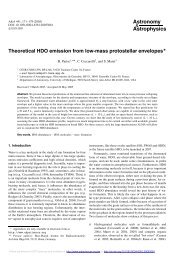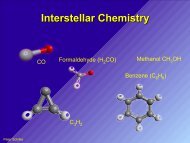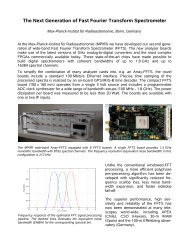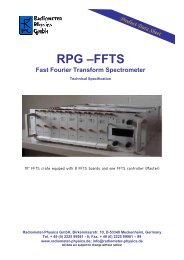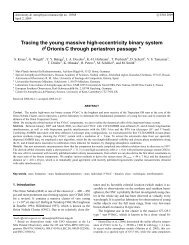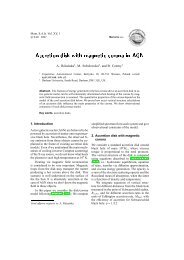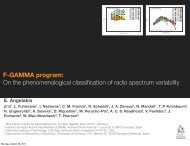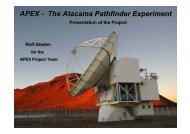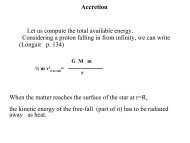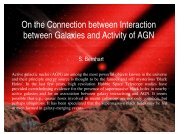Introduction to AIPS - Mpifr-bonn.mpg.de
Introduction to AIPS - Mpifr-bonn.mpg.de
Introduction to AIPS - Mpifr-bonn.mpg.de
Create successful ePaper yourself
Turn your PDF publications into a flip-book with our unique Google optimized e-Paper software.
http://www.aoc.nrao.edu/aips/
Some <strong>AIPS</strong> His<strong>to</strong>ry I<br />
●<br />
●<br />
Design began in 1979 in Charlottesville for the VLA<br />
Design criteria of the software<br />
– Transportable (space and time)<br />
– Software needs <strong>to</strong> be general and flexible<br />
– Interactive<br />
– Efficient with computer resources<br />
– User friendly and powerful<br />
– Multiple interactive users and batch-like usage<br />
– Well documented, uniformity in coding standards
Some <strong>AIPS</strong> His<strong>to</strong>ry II<br />
●<br />
●<br />
●<br />
●<br />
●<br />
●<br />
●<br />
●<br />
Designed initially on Modcomp computers with<br />
floating point array processor and special television<br />
display<br />
Next DEC VAX 11/780 with AP and TV<br />
FORTRAN66 (std. not well <strong>de</strong>fined ! → portability)<br />
Early <strong>AIPS</strong> ran on Modcomps, VAXes, UNIX, IBM, Cray<br />
People involved: Eric Greisen, Bill Cot<strong>to</strong>n, and others<br />
At present 1 <strong>to</strong> 2 people support <strong>AIPS</strong><br />
Is now FORTRAN77 + system <strong>de</strong>pen<strong>de</strong>nt routines in C<br />
Some (Bourne) shell scripts and PERL (installation)
Structure of <strong>AIPS</strong> I<br />
●<br />
FITS <strong>de</strong>velopment influenced <strong>AIPS</strong> data structures<br />
– <strong>AIPS</strong> hea<strong>de</strong>r binary representation of the FITS<br />
hea<strong>de</strong>r<br />
– Disk structure:<br />
●<br />
●<br />
●<br />
●<br />
Hea<strong>de</strong>r file<br />
Image or UV-data file<br />
Extension files (tables, plot files, his<strong>to</strong>ry)<br />
<strong>AIPS</strong> main program: aips<br />
– User interaction, input from RUN files (text)<br />
– POPS command interpreter<br />
●<br />
TASKS (large number of) started by aips
FITS<br />
Flexible Image Transport System<br />
http://en.wikipedia.org/wiki/FITS<br />
http://fits.gsfc.nasa.gov/<br />
●<br />
●<br />
●<br />
Multi-dimensional arrays: 1D spectra, 2D<br />
images, 3D+ data cubes<br />
Tables containing rows and columns of<br />
information<br />
Hea<strong>de</strong>r keywords provi<strong>de</strong> <strong>de</strong>scriptive<br />
information about the data (human readable)<br />
(80 character fixed-length strings)
<strong>AIPS</strong> structure II<br />
●<br />
Communication via the aips program<br />
– Language is POPS<br />
– Interactive or via text file<br />
●<br />
Define values of ADVERBS<br />
– Adverbs are in common <strong>to</strong> all tasks !<br />
●<br />
●<br />
Use VERBS (built in<strong>to</strong> aips)<br />
Execute TASKS asynchronously/synchronously<br />
– Task parameters (adverbs) <strong>de</strong>fined in “Help file”<br />
– Note: tasks can be created or modified without modification<br />
of aips
4 ERI CW. GREISEN<br />
User<br />
Terminal<br />
Disk<br />
text<br />
Files<br />
GO<br />
<strong>AIPS</strong><br />
Symbol Table<br />
Adverb Values<br />
POPS Language<br />
Interpret/compile<br />
Cause execution<br />
Application Verb Routines<br />
. . . . . . TV and TEK<br />
Verbs<br />
SAVE SUBMIT<br />
GET<br />
disk<br />
<strong>AIPS</strong>C<br />
``Checker' '<br />
Full POPS Language<br />
Very little applications<br />
disk<br />
<strong>AIPS</strong>B<br />
disk<br />
Data<br />
Disks<br />
tapes<br />
TV, Graphics<br />
Devices<br />
Image catalog<br />
disk<br />
Symbol Table<br />
Adverb Values<br />
POPS Language<br />
Interpret/compile<br />
Cause execution<br />
Pool of separate ``task' ' programs<br />
FITLD CALIB IMAGR . . . .<br />
FITAB<br />
Application Verb Routines<br />
. . . . . . SAVE<br />
GO xxxxxx xxxxx<br />
GET
<strong>AIPS</strong> windows<br />
●<br />
●<br />
●<br />
Console window for input/output <strong>to</strong>/from <strong>AIPS</strong><br />
TV output/input<br />
– Original TV output is now via emula<strong>to</strong>rs<br />
Line graphics<br />
– Emulation of Tektronix Terminal via xterm<br />
●<br />
Messages in Message Window
<strong>AIPS</strong> data files<br />
●<br />
●<br />
UV-data<br />
– Multi source files<br />
●<br />
●<br />
●<br />
Raw data from correla<strong>to</strong>rs<br />
needs: SU table<br />
All calibration info in CL table<br />
– Single source files<br />
●<br />
●<br />
Map files<br />
usually after SPLIT and averaging<br />
Usually calibrated data, no CL table
More on <strong>AIPS</strong><br />
●<br />
<strong>AIPS</strong> Versions<br />
– tst (31DEC07, might get updated via midnite job)<br />
– new (31DEC06, stable)<br />
– old<br />
●<br />
<strong>AIPS</strong> extensively uses environment variables<br />
– Defined through LOGIN.SH/LOGIN.CSH<br />
– and $CDTST, $CDNEW for compiling etc.
$<strong>AIPS</strong>_ROOT<br />
●<br />
●<br />
●<br />
In $<strong>AIPS</strong>_ROOT the most important files/direc<strong>to</strong>ries are:<br />
– 31DEC07 LOGIN.SH HOSTS.LIST DA00 RUN TEXT<br />
In 31DEC07 the most important files are:<br />
– <strong>AIPS</strong> APL QY Y HELP LINUX Q RUN SYSTEM<br />
They all branch further down<br />
– Source files xxxxx.FOR, xxxxx.C<br />
– At the lowest level are system <strong>de</strong>pen<strong>de</strong>nt routines<br />
– Files with extension .HLP in the HELP direc<strong>to</strong>ry<br />
– .EXE files in LINUX/LOAD
<strong>AIPS</strong>' virtual operating system<br />
For portability reasons a “virtual <strong>de</strong>vice interface”<br />
for file handling implemented<br />
●<br />
<strong>AIPS</strong> catalog<br />
– “flat” file system, organised in “disks”<br />
– Can reor<strong>de</strong>r, rename and <strong>de</strong>lete catalog entries<br />
– User ID (on disk in exten<strong>de</strong>d HEX)<br />
– <strong>AIPS</strong> data “disk” can be shared<br />
<strong>AIPS</strong> 1: Catalog on disk 1<br />
<strong>AIPS</strong> 1: Cat Usid Mapname Class Seq Pt Last access Stat<br />
<strong>AIPS</strong> 1: 1 333 TEST .UVSRT . 1 UV 24-MAY-2007 11:39:27 WRIT<br />
<strong>AIPS</strong> 1: 2 333 TEST .UVSRT . 2 UV 24-MAY-2007 11:40:40 WRIT
<strong>AIPS</strong> “disks” and “files”<br />
●<br />
●<br />
<strong>AIPS</strong> “disk” is a direc<strong>to</strong>ry on a disk (file system)<br />
(<strong>de</strong>fined in e.g. in ~/.da<strong>de</strong>vs or<br />
$NET0/DADEVS.LIST)<br />
<strong>AIPS</strong> “file” are a bunch of files in that direc<strong>to</strong>ry<br />
-rw-rw-r-- 1 alef aips 10240 2006-08-02 14:40 AND005001.07O;<br />
-rw-rw-r-- 1 alef aips 2048 2006-08-02 14:40 CBD005001.07O;<br />
-rw-rw-r-- 1 alef aips 8192 2006-08-02 14:40 FQD005001.07O;<br />
-rw-rw-r-- 1 alef aips 125952 2006-08-02 14:40 HID005001.07O;<br />
-rw-rw-r-- 1 alef aips 4498432 2006-08-02 14:40 UVD005001.07O;<br />
-rw-rw-r-- 1 alef aips<br />
21504 2007-03-07 12:41 CAD000000.07O;
-rw-rw-r-- 1 alef aips 10240 2006-03-03 15:12 AND004001.07O;<br />
-rw-rw-r-- 1 alef aips 2048 2006-08-31 16:53 CBD004001.07O;<br />
-rw-rw-r-- 1 alef aips 28727296 2006-03-03 15:12 CLD004001.07O;<br />
-rw-rw-r-- 1 alef aips 28727296 2006-03-03 15:15 CLD004002.07O;<br />
-rw-rw-r-- 1 alef aips 29696 2006-08-31 16:49 FGD004001.07O;<br />
-rw-rw-r-- 1 alef aips 8192 2006-03-03 15:12 FQD004001.07O;<br />
-rw-rw-r-- 1 alef aips 172032 2006-03-14 15:24 GCD004001.07O;<br />
-rw-rw-r-- 1 alef aips 7936000 2006-03-03 15:12 HFD004001.07O;<br />
-rw-rw-r-- 1 alef aips 95232 2006-08-31 16:53 HID004001.07O;<br />
-rw-rw-r-- 1 alef aips 15360 2006-03-03 15:12 NXD004001.07O;<br />
-rw-rw-r-- 1 alef aips 84992 2006-03-15 13:25 PLD004001.07O;<br />
-rw-rw-r-- 1 alef aips 361472 2006-03-14 09:32 SND004001.07O;<br />
-rw-rw-r-- 1 alef aips 9216 2006-03-03 15:12 SUD004001.07O;<br />
-rw-rw-r-- 1 alef aips 107520 2006-03-14 15:24 TYD004001.07O;<br />
-rw-rw-r-- 1 alef aips 59023360 2006-03-03 15:15 UVD004001.07O;<br />
The <strong>de</strong>sired end product is the final calibration or CL-table !!
-rw-rw-r-- 1 alef aips 2048 2000-12-12 12:12 CBD02C001.07O;<br />
-rw-rw-r-- 1 alef aips 16384 2000-12-12 12:12 CCD02C001.07O;<br />
-rw-rw-r-- 1 alef aips 74752 2000-12-12 12:12 HID02C001.07O;<br />
-rw-rw-r-- 1 alef aips 1048576 2000-12-12 12:12 MAD02C001.07O;
Summary<br />
●<br />
●<br />
●<br />
●<br />
●<br />
●<br />
<strong>AIPS</strong> holds data in files with tables<br />
<strong>AIPS</strong> “files” are organised in <strong>AIPS</strong> “disks”<br />
The direc<strong>to</strong>ry of each “disk” can be listed, etc.<br />
Calibration of UV data is not applied <strong>to</strong> the data<br />
but accumulated in CL tables<br />
Solutions of calibration programs are written <strong>to</strong><br />
SN-tables<br />
SN-tables are written in<strong>to</strong> CL-tables (CLCAL)
<strong>AIPS</strong> start-up sequence<br />
●<br />
or<br />
●<br />
<strong>AIPS</strong>_ROOT=/homes/<strong>AIPS</strong>; export <strong>AIPS</strong>_ROOT<br />
SETENV <strong>AIPS</strong>_ROOT /homes/<strong>AIPS</strong><br />
●<br />
or<br />
●<br />
. $<strong>AIPS</strong>_ROOT/LOGIN.SH<br />
SOURCE $<strong>AIPS</strong>_ROOT/LOGIN.CSH
<strong>AIPS</strong> start-up sequence<br />
●<br />
●<br />
●<br />
●<br />
<strong>AIPS</strong>_MSG_EXE_FLAG='-sb -sl 900 -e';<br />
export <strong>AIPS</strong>_MSG_EXE_FLAG<br />
setenv ME /aux/vlb045/alef/aips<br />
setenv <strong>AIPS</strong>_TEK_EMULATOR none<br />
setenv <strong>AIPS</strong>REMOTE "ssh -n"
<strong>AIPS</strong> start-up sequence<br />
●<br />
●<br />
●<br />
●<br />
●<br />
<strong>AIPS</strong>_MSG_EXE_FLAG='-sb -sl 900 -e';<br />
export <strong>AIPS</strong>_MSG_EXE_FLAG<br />
setenv ME /aux/vlb045/alef/aips<br />
setenv <strong>AIPS</strong>_TEK_EMULATOR none<br />
setenv <strong>AIPS</strong>REMOTE "ssh -n"<br />
Now let's do it !<br />
aips [tst] [tv={my computer|local}]<br />
– MANPATH=$<strong>AIPS</strong>_ROOT/31DEC07/SYSTEM/UNIX:...<br />
– man aips
<strong>AIPS</strong> for beginners I<br />
●<br />
●<br />
●<br />
●<br />
●<br />
●<br />
●<br />
●<br />
Start-up messages<br />
help, explain, apropos, about<br />
Define adverbs, save and get adverbs, inputs<br />
Messages<br />
<strong>AIPS</strong> direc<strong>to</strong>ry<br />
“getn” files, clrstat, zap, recat<br />
List hea<strong>de</strong>rs of UV and MAP files<br />
Look at a typical tables
<strong>AIPS</strong> for beginners II<br />
●<br />
●<br />
●<br />
●<br />
●<br />
●<br />
●<br />
●<br />
Multi and single source UV-files<br />
<strong>AIPS</strong> his<strong>to</strong>ry<br />
tput, tget<br />
tvlod<br />
possm<br />
vplot<br />
snplt<br />
Tapes (DAT), external disk files
<strong>AIPS</strong> for beginners III<br />
●<br />
●<br />
Read FITS data in<strong>to</strong> <strong>AIPS</strong> with FITLD<br />
Write data out with FITAB or FITTP
Tips and tricks<br />
●<br />
●<br />
●<br />
●<br />
●<br />
Define your own <strong>AIPS</strong> “disks” for projects<br />
Use different <strong>AIPS</strong> IDs for different projects<br />
Don't use disks for writing (scratch) over NFS<br />
More than 1 physical disk helps (e.g. sorting)<br />
READ THE COOKBOOK!!!
<strong>AIPS</strong> tables I<br />
●<br />
●<br />
●<br />
●<br />
●<br />
●<br />
AN Antenna table. Contains a list of the antenna names and station<br />
coordinates. Also contains instrumental polarization terms.<br />
AT Antenna characteristics table. Contains additional information about<br />
antenna properties, including some time variable quantities.<br />
BL Baseline offset table. Contains non-closing baseline-<strong>de</strong>pen<strong>de</strong>nt phase<br />
and amplitu<strong>de</strong> errors as <strong>de</strong>termined by BLCAL.<br />
BS Baseline solution table. Contains baseline <strong>de</strong>lay, rate and phase<br />
solutions as <strong>de</strong>termined by BLING<br />
CL Calibration table. Version 1 contains, amongst other things, the<br />
<strong>de</strong>fault calibration parameters for the amplitu<strong>de</strong> (usually unity), phase,<br />
and single-band <strong>de</strong>lay (usually zero) for each source for each IF as a<br />
function of time. It also contains polynomial coefficients allowing the<br />
correla<strong>to</strong>r <strong>de</strong>lay and phase mo<strong>de</strong>ls <strong>to</strong> be recomputed. As calibration<br />
proceeds, higher versions of this table are created which incorporate<br />
more and more calibration effects in<strong>to</strong> the phase, <strong>de</strong>lay, and amplitu<strong>de</strong><br />
entries.<br />
CQ Correla<strong>to</strong>r parameter frequency table. Contains VLBA correlation<br />
parameters for each <strong>AIPS</strong> IF, and activates VLBA <strong>de</strong>lay <strong>de</strong>correlation<br />
corrections.<br />
●
<strong>AIPS</strong> tables II<br />
CT CALC table. Contains the input parameters passed <strong>to</strong> CALC <strong>to</strong> generate the<br />
polynomials recor<strong>de</strong>d in the IM table.<br />
FG Flag table. Contains information used <strong>to</strong> <strong>de</strong>lete selected portions of the data.<br />
FQ Frequency table. Contains information about the IF frequencies, channel spacings,<br />
bandwidths, etc.<br />
GC Gain Calibration table. Contains the expected zenith gain and gain-elevation curve for<br />
each antenna. It is used for amplitu<strong>de</strong> calibration.<br />
HF Haystack FRNGE table. Contains information generated from the \<strong>AIPS</strong>\ tables that<br />
can be exported <strong>to</strong> the CALC and SOLVE package.<br />
IM Interferometer mo<strong>de</strong>l table. Contains the actual polynomial coefficients which the VLBA<br />
correla<strong>to</strong>r used <strong>to</strong> calculate the geometrical mo<strong>de</strong>l. Unlike the coefficients in the CL<br />
table, these have not been re-interpolated on<strong>to</strong> the CL time grid, but have time stamps<br />
corresponding <strong>to</strong> the times at which the correla<strong>to</strong>r computed the geometrical mo<strong>de</strong>l.<br />
MC Mo<strong>de</strong>l Components table. Contains the various components of the geometric mo<strong>de</strong>l<br />
used in the VLBA correla<strong>to</strong>r <strong>to</strong> generate the IM table.<br />
NX In<strong>de</strong>x File. Contains information about the time, source, sub-array and location within<br />
the data file of each observation or “scan”. It is used by some <strong>AIPS</strong> tasks in accessing<br />
the main data file and subsidiary tables.<br />
OB Spacecraft Orbit table. Contains information about the positions and velocities used by<br />
the correla<strong>to</strong>r for an orbiting antenna.
<strong>AIPS</strong> tables III<br />
PC Phase-calibration table. Contains phases within each IF computed from the injected<br />
phase calibration signals. It is used <strong>to</strong> <strong>de</strong>termine the phase offsets and single-band<br />
<strong>de</strong>lays for each IF channel.<br />
SN Solution table. Contains antenna <strong>de</strong>lay, rate, phase, and amplitu<strong>de</strong> corrections<br />
solved for by CALIB and FRING and other tasks.<br />
SU Source table. Contains a list of the sources found within the multi-source file, including<br />
information on source positions and flux <strong>de</strong>nsity.<br />
TY System temperature table. Contains the system temperature as a function of time for<br />
each antenna and IF channel. It is used for amplitu<strong>de</strong> calibration.<br />
VT VLBA Tape table. Contains tape playback statistics for use mainly by the VLBA<br />
correla<strong>to</strong>r group.<br />
WX Weather table. Contains weather-related information for each station.
You need <strong>to</strong> do something special<br />
●<br />
You could write your own <strong>AIPS</strong> task<br />
– FORTRAN is easy, but <strong>AIPS</strong> FORTRAN !<br />
– Read the documentation: GOING <strong>AIPS</strong> I & II<br />
– Start from an existing program !<br />
– Use one of the template programs<br />
●<br />
Use ParselTongue<br />
– It allows you <strong>to</strong> run <strong>AIPS</strong> tasks and access <strong>AIPS</strong><br />
hea<strong>de</strong>rs and <strong>AIPS</strong> extension tables from Python<br />
http://www.radionet-eu.org/rnwiki/ParselTongue
Additional recipies



